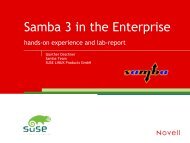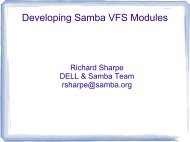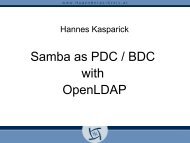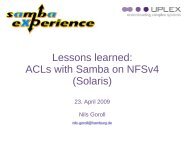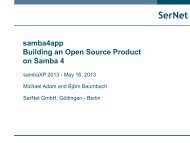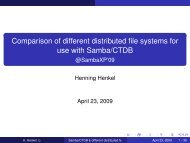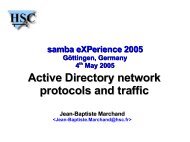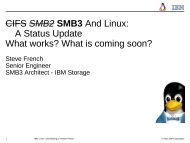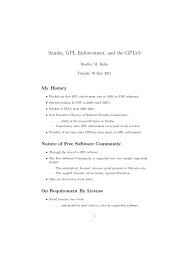Clustering Samba With CTDB A Tutorial At sambaXP 2010
Clustering Samba With CTDB A Tutorial At sambaXP 2010
Clustering Samba With CTDB A Tutorial At sambaXP 2010
Create successful ePaper yourself
Turn your PDF publications into a flip-book with our unique Google optimized e-Paper software.
<strong>Clustering</strong> <strong>Samba</strong> <strong>With</strong> <strong>CTDB</strong><br />
A <strong>Tutorial</strong> <strong>At</strong> <strong>sambaXP</strong> <strong>2010</strong><br />
Michael Adam<br />
obnox@samba.org<br />
SerNet / <strong>Samba</strong> Team<br />
<strong>2010</strong>-05-05
Outline<br />
Outline<br />
1 Cluster Challenges<br />
Introduction<br />
Challenges For <strong>Samba</strong><br />
2 <strong>CTDB</strong><br />
The <strong>CTDB</strong> Project<br />
<strong>CTDB</strong> Design<br />
Setting Up <strong>CTDB</strong><br />
3 Clustered <strong>Samba</strong><br />
Getting Sources and Binaries<br />
Clustered File Systems<br />
<strong>Samba</strong> Configuration<br />
<strong>CTDB</strong> manages...<br />
Registry Configuration<br />
Michael Adam (SerNet / <strong>Samba</strong> Team) tutorial <strong>sambaXP</strong> <strong>2010</strong>-05-05 2 / 43
Cluster Challenges<br />
Introduction<br />
Ideas<br />
quite common: clustered web servers and database servers...<br />
idea: share a cluster file system as a network service (NFS/CIFS)<br />
i.e. turn your SAN into a clustered NAS<br />
⇒ we want to cluster <strong>Samba</strong>/nfs in an all-active fashion<br />
with <strong>CTDB</strong>, we can cluster <strong>Samba</strong> (and nfs, and ...)<br />
Michael Adam (SerNet / <strong>Samba</strong> Team) tutorial <strong>sambaXP</strong> <strong>2010</strong>-05-05 4 / 43
Cluster Challenges<br />
Introduction<br />
Starting Points<br />
<strong>Samba</strong> daemons on cluster nodes need to act as one CIFS server:<br />
consistent view of file ownership<br />
windows file lock coherence<br />
hence we need IPC of <strong>Samba</strong> daemons between nodes<br />
furthermode share some persistent data<br />
Michael Adam (SerNet / <strong>Samba</strong> Team) tutorial <strong>sambaXP</strong> <strong>2010</strong>-05-05 5 / 43
Challenges For <strong>Samba</strong><br />
Cluster Challenges<br />
Challenges For <strong>Samba</strong><br />
IPC: messaging (messages.tdb and signals)<br />
IPC: share volatile session data:<br />
SMB sessions (sessionid.tdb)<br />
share connections (connections.tdb)<br />
share modes (locking.tdb)<br />
byte range locks (brlock.tdb)<br />
share certain persistent data:<br />
user database (passdb.tdb)<br />
domain join information (secrets.tdb)<br />
id mapping tables (winbindd idmap.tdb)<br />
registry (registry.tdb)<br />
Michael Adam (SerNet / <strong>Samba</strong> Team) tutorial <strong>sambaXP</strong> <strong>2010</strong>-05-05 6 / 43
Cluster Challenges<br />
Challenges For <strong>Samba</strong><br />
TDBs<br />
most problems are about distributing TDBs in the cluster<br />
TDB: small fast Berkeley-DB-style database with record locks and<br />
memory mapping<br />
volatile (“normal”) TDBs:<br />
read and written very frequently<br />
not all data must be known to every node (or smbd process) at each<br />
point in time<br />
R/W performance critical for overall fileserver performance<br />
especially important for the Windows locks<br />
persistent TDBs:<br />
read frequently<br />
written rather rarely<br />
data consistency very important<br />
Michael Adam (SerNet / <strong>Samba</strong> Team) tutorial <strong>sambaXP</strong> <strong>2010</strong>-05-05 7 / 43
Cluster Challenges<br />
Challenges For <strong>Samba</strong><br />
TDBs And <strong>Clustering</strong><br />
TDB R/W performance critical for <strong>Samba</strong> performance<br />
TDB R/W operations: excessive use of POSIX fcntl byte range<br />
locks<br />
fcntl locks are usually slow on cluster file systems<br />
the more nodes, the slower...<br />
⇒ naive approach of putting TDBs on cluster storage works in<br />
principle but scales very badly<br />
Usual clustered data bases are also too slow.<br />
A more clever approach is needed.<br />
Michael Adam (SerNet / <strong>Samba</strong> Team) tutorial <strong>sambaXP</strong> <strong>2010</strong>-05-05 8 / 43
Cluster Challenges<br />
Challenges For <strong>Samba</strong><br />
Goals<br />
Cluster <strong>Samba</strong> So That:<br />
One node is not slower than an unclustered <strong>Samba</strong> server.<br />
n + 1 nodes should be faster than n nodes.<br />
This in requires a clustered TDB implementation ...<br />
... and messaging solution.<br />
This is what <strong>CTDB</strong> provides.<br />
Michael Adam (SerNet / <strong>Samba</strong> Team) tutorial <strong>sambaXP</strong> <strong>2010</strong>-05-05 9 / 43
<strong>CTDB</strong><br />
The <strong>CTDB</strong> Project<br />
The <strong>CTDB</strong> Project<br />
started in 2006<br />
first prototype in vl-messaging SVN branch<br />
Volker Lendecke, Andrew Tridgell, ...<br />
first usable version of <strong>CTDB</strong>: April 2007<br />
meanwhile: Ronnie Sahlberg project maintainer<br />
git://git.samba.org/sahlberg/ctdb.git<br />
http://ctdb.samba.org/packages/ (RPMs, Sources)<br />
Michael Adam (SerNet / <strong>Samba</strong> Team) tutorial <strong>sambaXP</strong> <strong>2010</strong>-05-05 11 / 43
<strong>CTDB</strong><br />
The <strong>CTDB</strong> Project<br />
The <strong>CTDB</strong> Project - Relases<br />
to be honest: There is no real release process.<br />
version number and changelog in packaging/RPM/ctdb.spec.in<br />
version in the master branch is incremented more or less frequently<br />
some versions stabilize in extra branches: 1.0.69, 1.0.82, 1.0.108,<br />
1.0.112, ...<br />
Hint: packagers better check with developers for advice on versions!<br />
Michael Adam (SerNet / <strong>Samba</strong> Team) tutorial <strong>sambaXP</strong> <strong>2010</strong>-05-05 12 / 43
<strong>CTDB</strong><br />
The <strong>CTDB</strong> Project<br />
The <strong>CTDB</strong> Project - Community<br />
#ctdb channel on freenode<br />
samba-technical mailing list<br />
feedback and contributions by packagers<br />
increasing development activity, number of developers<br />
Michael Adam (SerNet / <strong>Samba</strong> Team) tutorial <strong>sambaXP</strong> <strong>2010</strong>-05-05 13 / 43
<strong>CTDB</strong><br />
<strong>CTDB</strong> Design<br />
<strong>CTDB</strong> Design - Warning<br />
A Word Of Warning<br />
Client connections are not spread over multiple cluster nodes.<br />
I.e., each single client connection (CIFS, nfs, ...) is serverd by one<br />
node just as a non-clustered file server would server the connection.<br />
Hence a single connection is not faster than on a non-clustered file<br />
server, but the sum should (possibly) be faster.<br />
In case of failover, connections are not migrated: clients need to<br />
reconnect.<br />
Michael Adam (SerNet / <strong>Samba</strong> Team) tutorial <strong>sambaXP</strong> <strong>2010</strong>-05-05 14 / 43
<strong>CTDB</strong><br />
<strong>CTDB</strong> Design<br />
<strong>CTDB</strong> Design – General<br />
one daemon ctdbd on each node (and temporary forks)<br />
smbd talks to local ctdbd for messaging and TDB access<br />
ctdbd handles metadata of TDBs via the network<br />
ctdbd keeps local TDB copy (LTDB) for fast data reads/writes<br />
the actual record read and write ops are directly to the LTDB<br />
normal and persistent TDBs are handled differently<br />
HA and cluster management features: monitor and fail over/back IP<br />
addresses and <strong>Samba</strong>, NFS and other services<br />
Michael Adam (SerNet / <strong>Samba</strong> Team) tutorial <strong>sambaXP</strong> <strong>2010</strong>-05-05 15 / 43
<strong>CTDB</strong><br />
<strong>CTDB</strong> Design<br />
<strong>CTDB</strong> Design – normal TDBs<br />
one node does not need to know all records all the time:<br />
the records related to connections to a node are node specific<br />
when a node goes down:<br />
⇒ we may, even should lose records specific to that node<br />
a node only has those records in its LTDB that is has already accessed<br />
Michael Adam (SerNet / <strong>Samba</strong> Team) tutorial <strong>sambaXP</strong> <strong>2010</strong>-05-05 16 / 43
<strong>CTDB</strong><br />
<strong>CTDB</strong> Design - Record Roles<br />
<strong>CTDB</strong> Design<br />
nodes can carry certain roles with respect to a record:<br />
DMASTER (data master):<br />
has the current, authoritative copy of a record<br />
moves around as nodes write to the record<br />
LMASTER (location master):<br />
knows the location of a record’s DMASTER<br />
is fixed (calculated by record hash)<br />
LMASTER roles distributed across active nodes<br />
R/W operation to a record:<br />
check if we are DMASTER<br />
if not, request DMASTER role and current copy of record over network<br />
(via LMASTER)<br />
read/write locally<br />
Michael Adam (SerNet / <strong>Samba</strong> Team) tutorial <strong>sambaXP</strong> <strong>2010</strong>-05-05 17 / 43
<strong>CTDB</strong><br />
<strong>CTDB</strong> Design<br />
Recovery<br />
what happens if a node goes down<br />
data master for some records will be lost<br />
one node – the recovery master – performs recovery<br />
recovery master collects most recent copy of all records from all nodes<br />
additional TDB header record sequence number determines recentness<br />
at the end, the recovery master is data master for all records<br />
Michael Adam (SerNet / <strong>Samba</strong> Team) tutorial <strong>sambaXP</strong> <strong>2010</strong>-05-05 18 / 43
<strong>CTDB</strong><br />
<strong>CTDB</strong> Design<br />
Recovery Election / Recovery Lock<br />
recovery master is determined by an election process<br />
if the cluster file system supports POSIX fcntl byte range locks,<br />
then <strong>CTDB</strong> can use it for split brain prevention:<br />
election process can involve one file on shared storage:<br />
the recovery lock file<br />
nodes compete with POSIX fcntl byte range locks<br />
finally, the newly elected recovery master holds lock on the recovery<br />
lock file<br />
⇒ <strong>CTDB</strong> has no split brain (other than the file system)<br />
Michael Adam (SerNet / <strong>Samba</strong> Team) tutorial <strong>sambaXP</strong> <strong>2010</strong>-05-05 19 / 43
<strong>CTDB</strong><br />
<strong>CTDB</strong> Design<br />
Performance Figures<br />
By Andrew Tridgell and Ronnie Sahlberg, Linux Conf Australia 2009<br />
GPFS file system<br />
32 client smbtorture NBENCH test<br />
1 node: 109 MBytes/sec<br />
2 nodes: 210 MBytes/sec<br />
3 nodes: 278 MBytes/sec<br />
4 nodes: 308 MBytes/sec<br />
Michael Adam (SerNet / <strong>Samba</strong> Team) tutorial <strong>sambaXP</strong> <strong>2010</strong>-05-05 20 / 43
<strong>CTDB</strong><br />
<strong>CTDB</strong> Design<br />
<strong>CTDB</strong> Design – persistent TDBs<br />
each node always has complete copy in LTDB<br />
reads operations directly from LTDB<br />
write operations:<br />
lock entire DB in a global lock<br />
perform R/W ops in memory (prepare a marshall buffer)<br />
at commit distribute changes to other nodes and write to LTDB in a<br />
local transaction<br />
finally drop global lock<br />
⇒ data integrity and good read performance guaranteed<br />
Michael Adam (SerNet / <strong>Samba</strong> Team) tutorial <strong>sambaXP</strong> <strong>2010</strong>-05-05 21 / 43
<strong>CTDB</strong> - Basic Setup<br />
<strong>CTDB</strong><br />
Setting Up <strong>CTDB</strong><br />
Michael Adam (SerNet / <strong>Samba</strong> Team) tutorial <strong>sambaXP</strong> <strong>2010</strong>-05-05 22 / 43
<strong>CTDB</strong><br />
Setting Up <strong>CTDB</strong><br />
<strong>CTDB</strong> - Configuration<br />
central file: /etc/sysconfig/ctdb<br />
debian based: /etc/default/ctdb<br />
set <strong>CTDB</strong> RECOVERY LOCK for split brain prevention<br />
fill /etc/ctdb/nodes with internal node addresses<br />
example /etc/ctdb/nodes<br />
10.11.12.10<br />
10.11.12.11<br />
10.11.12.12<br />
same file on all nodes!<br />
Michael Adam (SerNet / <strong>Samba</strong> Team) tutorial <strong>sambaXP</strong> <strong>2010</strong>-05-05 23 / 43
<strong>CTDB</strong><br />
Setting Up <strong>CTDB</strong><br />
<strong>CTDB</strong> - Public Addresses<br />
set <strong>CTDB</strong> PUBLIC ADDRESSES in /etc/sysconfig/ctdb<br />
typical value /etc/ctdb/public addresses<br />
example /etc/ctdb/public addresses<br />
172.16.17.10/24 eth2<br />
172.16.17.11/24 eth2<br />
172.16.17.12/24 eth2<br />
172.16.17.13/24 eth2<br />
172.16.17.14/24 eth2<br />
172.16.17.15/24 eth2<br />
need not be the same on all nodes<br />
need not even be present on all nodes (management node...)<br />
Michael Adam (SerNet / <strong>Samba</strong> Team) tutorial <strong>sambaXP</strong> <strong>2010</strong>-05-05 24 / 43
<strong>CTDB</strong><br />
Setting Up <strong>CTDB</strong><br />
IP Failover<br />
healthy nodes get IP addresses from their public pool<br />
when a node goes down: public IPs are moved to other nodes<br />
<strong>CTDB</strong> distributes the public IPs equally among healthy nodes<br />
with round robin DNS ⇒ HA and load balancing<br />
speed up client reconnects with tickle ACKs:<br />
client does not yet know the IP has moved<br />
new node does not have a valid TCP connection to client<br />
new node sends illegal TCP ACK packet to the client (seqnum 0)<br />
client sends back correct ACK packet to the new node<br />
new node sends back a RST packet to the client<br />
client re-establishes connection to the new node<br />
Michael Adam (SerNet / <strong>Samba</strong> Team) tutorial <strong>sambaXP</strong> <strong>2010</strong>-05-05 25 / 43
<strong>CTDB</strong><br />
Setting Up <strong>CTDB</strong><br />
<strong>CTDB</strong> Toolbox<br />
ctdb – control ctdbd<br />
onnode – execute programs on selected nodes<br />
Michael Adam (SerNet / <strong>Samba</strong> Team) tutorial <strong>sambaXP</strong> <strong>2010</strong>-05-05 26 / 43
ctdb status<br />
<strong>CTDB</strong><br />
Setting Up <strong>CTDB</strong><br />
Michael Adam (SerNet / <strong>Samba</strong> Team) tutorial <strong>sambaXP</strong> <strong>2010</strong>-05-05 27 / 43
ctdb ip<br />
<strong>CTDB</strong><br />
Setting Up <strong>CTDB</strong><br />
Michael Adam (SerNet / <strong>Samba</strong> Team) tutorial <strong>sambaXP</strong> <strong>2010</strong>-05-05 28 / 43
<strong>CTDB</strong><br />
Setting Up <strong>CTDB</strong><br />
Let’s start setting up a “real” cluster.<br />
Michael Adam (SerNet / <strong>Samba</strong> Team) tutorial <strong>sambaXP</strong> <strong>2010</strong>-05-05 29 / 43
Clustered <strong>Samba</strong><br />
Getting Sources and Binaries<br />
Getting A Clustered <strong>Samba</strong><br />
in vanilla <strong>Samba</strong> code since <strong>Samba</strong> 3.3 (January 2009)<br />
transaction rewrite in 3.5.2 (March <strong>2010</strong>)<br />
precompiled packages from http://www.enterprisesamba.org/<br />
clustered <strong>Samba</strong> repository:<br />
git://git.samba.org/obnox/samba-ctdb.git<br />
branches: v3-4-ctdb and v3-2-ctdb<br />
configure --with-cluster-support<br />
add idmap tdb2 to --with-shared-modules<br />
verify that gpfs.so is built for GPFS usage<br />
Michael Adam (SerNet / <strong>Samba</strong> Team) tutorial <strong>sambaXP</strong> <strong>2010</strong>-05-05 31 / 43
Clustered <strong>Samba</strong><br />
Clustered File Systems<br />
Clustered File System - Requirements<br />
file system: black box<br />
storage: fibre channel, iSCSI, drbd, ...<br />
simulatneous writes from all nodes<br />
good to have: coherent POSIX fcntl byte range lock support<br />
use ping pong test to verify<br />
Michael Adam (SerNet / <strong>Samba</strong> Team) tutorial <strong>sambaXP</strong> <strong>2010</strong>-05-05 32 / 43
Clustered <strong>Samba</strong><br />
Clustered File Systems<br />
Special File Systems<br />
General Parallel File System GPFS (IBM): OK<br />
Global File System GFS(2) (Red Hat): OK<br />
GNU Cluster File System GlusterFS: OK<br />
Lustre (Sun): OK<br />
Oracle Cluster File System OCFS(2): OK<br />
Ceph: <br />
Michael Adam (SerNet / <strong>Samba</strong> Team) tutorial <strong>sambaXP</strong> <strong>2010</strong>-05-05 33 / 43
Clustered <strong>Samba</strong><br />
<strong>Samba</strong> Configuration<br />
<strong>Samba</strong> Configuration<br />
identical configuration on all nodes<br />
clustering = yes<br />
passdb backen = tdbsam<br />
groupdb:backend = tdb<br />
vfs objects = fileid<br />
fileid:algorithm = fsid / fsname<br />
idmap backend = tdb2<br />
no need to change private dir<br />
Michael Adam (SerNet / <strong>Samba</strong> Team) tutorial <strong>sambaXP</strong> <strong>2010</strong>-05-05 34 / 43
Clustered <strong>Samba</strong><br />
<strong>Samba</strong> Configuration<br />
example smb.conf<br />
[global]<br />
clustering = yes<br />
netbios name = smbcluster<br />
workgroup = mydomain<br />
security = ads<br />
passdb backend = tdbsam<br />
groupdb:backend = tdb<br />
idmap backend = tdb2<br />
idmap uid = 1000000-2000000<br />
idmap gid = 1000000-2000000<br />
fileid:algorithm = fsname<br />
[share]<br />
path = /cluster storage/share<br />
writeable = yes<br />
vfs objects = fileid<br />
Michael Adam (SerNet / <strong>Samba</strong> Team) tutorial <strong>sambaXP</strong> <strong>2010</strong>-05-05 35 / 43
Clustered <strong>Samba</strong><br />
<strong>Samba</strong> Configuration<br />
Let’s configure <strong>Samba</strong> on our cluster!<br />
Michael Adam (SerNet / <strong>Samba</strong> Team) tutorial <strong>sambaXP</strong> <strong>2010</strong>-05-05 36 / 43
Clustered <strong>Samba</strong><br />
<strong>CTDB</strong> manages...<br />
<strong>CTDB</strong> manages ...<br />
<strong>CTDB</strong> can manage several services<br />
i.e. start, stop, monitor them<br />
controlled by sysconfig variables <strong>CTDB</strong> MANAGES SERVICE<br />
management performed by scripts in /etc/ctdb/events.d<br />
managed services should be removed from the runlevels<br />
NOTE: if <strong>CTDB</strong> MANAGES SAMBA, do not set<br />
interfaces or bind interfaces only<br />
Michael Adam (SerNet / <strong>Samba</strong> Team) tutorial <strong>sambaXP</strong> <strong>2010</strong>-05-05 37 / 43
Clustered <strong>Samba</strong><br />
<strong>CTDB</strong> manages...<br />
<strong>CTDB</strong> manages ...<br />
<strong>CTDB</strong> MANAGES SAMBA<br />
<strong>CTDB</strong> MANAGES WINBIND<br />
<strong>CTDB</strong> MANAGES NFS<br />
<strong>CTDB</strong> MANAGES VSFTPD<br />
<strong>CTDB</strong> MANAGES HTTPD<br />
Michael Adam (SerNet / <strong>Samba</strong> Team) tutorial <strong>sambaXP</strong> <strong>2010</strong>-05-05 38 / 43
Clustered <strong>Samba</strong><br />
Registry Configuration<br />
Registry Configuration<br />
store config in <strong>Samba</strong>’s registry<br />
HKLM\Software\<strong>Samba</strong>\smbconf<br />
subkey ⇔ section<br />
value ⇔ parameter<br />
stored in registry.tdb ⇒ distributed across cluster by <strong>CTDB</strong><br />
means of easily managing the whole <strong>Samba</strong> cluster<br />
Michael Adam (SerNet / <strong>Samba</strong> Team) tutorial <strong>sambaXP</strong> <strong>2010</strong>-05-05 39 / 43
Clustered <strong>Samba</strong><br />
Registry Configuration<br />
Activation of Registry Configuration<br />
registry shares = yes<br />
include = registry<br />
config backend = registry<br />
smb.conf for cluster usage<br />
[global]<br />
clustering = yes<br />
include = registry<br />
Michael Adam (SerNet / <strong>Samba</strong> Team) tutorial <strong>sambaXP</strong> <strong>2010</strong>-05-05 40 / 43
net conf<br />
Clustered <strong>Samba</strong><br />
Registry Configuration<br />
manage the whole <strong>Samba</strong> cluster with one command<br />
net conf list<br />
net conf listshares<br />
net conf import<br />
net conf drop<br />
net conf showshare<br />
net conf addshare<br />
net conf delshare<br />
net conf setparm<br />
net conf getparm<br />
net conf delparm<br />
net conf getincludes<br />
net conf setincludes<br />
net conf delincludes<br />
Dump the complete configuration in smb.conf format.<br />
List the share names.<br />
Import configuration from file in smb.conf format.<br />
Delete the complete configuration.<br />
Show the definition of a share.<br />
Create a new share.<br />
Delete a share.<br />
Store a parameter.<br />
Retrieve the value of a parameter.<br />
Delete a parameter.<br />
Show the includes of a share definition.<br />
Set includes for a share.<br />
Delete includes from a share definition.<br />
Michael Adam (SerNet / <strong>Samba</strong> Team) tutorial <strong>sambaXP</strong> <strong>2010</strong>-05-05 41 / 43
Clustered <strong>Samba</strong><br />
Registry Configuration<br />
Let’s experiment more with our cluster! ...<br />
Michael Adam (SerNet / <strong>Samba</strong> Team) tutorial <strong>sambaXP</strong> <strong>2010</strong>-05-05 42 / 43
Clustered <strong>Samba</strong><br />
Registry Configuration<br />
Thank you very much!<br />
Michael Adam (SerNet / <strong>Samba</strong> Team) tutorial <strong>sambaXP</strong> <strong>2010</strong>-05-05 43 / 43





